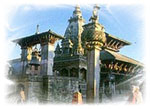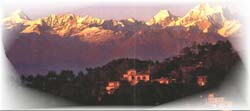|
| |
BHAKTAPUR ( BHADGAUN
)_________________ |
|
|
The city of devotes
is the third major town of the valley about 15 km from Kathmandu which
was the capital of the whole valley during the 14th to 16 th centuries.
It is the valley's best farm land where Newari Jyapu peasants produce
cauliflowers and rice. Still it is the most traditional most aggression
and the most Newar of the valley's three ancient kingdoms. The great
architecture of this city is from end of 17th century during the rule
of king Bhaktapur's Malla |
|
|
Durbar
Square :
Contains innumerable temples and other architectural showpieces
like the lion gate, the statue of king Bhupanindra Malla,
the picture gallery, the golden gate, the place of 55 windows,
the bastala temple and the bell of barkin dogs etc.
Bhaktapur Royal palace
:
Bhaktapur Royal Palace was founded by Yaksha malla (B.S.1428-1482)
and added it to my successive kings, Particularly Bhupindra
malla (1696-1722). The octagonal temple known as Chyasilin
Mandap was one of the finest in the square until it was destroyed
by the 1934 earthquake. |
|
|
|
- The GOLDEN GATE is the entrance to the main countered of the
place of 55 windows; it was built by King Ranjit Malla. The gate
is one of the most beautiful and richly covered specimens of the
king in the entire world.
- The palace of 55 windows was built in the seventeenth century
by King Bhupatindra Malla. Among the bricks walls with their gracious
setting and sculptural design, is a balcony of 55 windows which
is a masterpiece of wood carving.
- Nyatpola temple is five-storey pagoda built in 1702 A.D.. by
king Bhuptindra Malla. He also built Bhairavnath temple, the god
of terror Dattatreya temple was built from trunk of a single tree.
Near this temple is a monastery with exquisitely covered peacock
windows.
Changu Narayan is built by King Hari Dutta in 323 A.D. and said
to be the oldest temple in the valley.
|
| SOME
POPULAR PLACE TO VISIT |
| NAGARKOT______________________
The best spot to view the significant views of mountains,
on the ridge on the north-eastern rim of the valley is about
30 kms. from Katmandu at on altitude of 3000 m. the view extends
all the way from Dhauligiri in the most to Kanchanjunga in
the east. There is tower on the top from where you can view
the mountains at 360 degree, however early morning is the
best to visit. |
|
|
DAMAN__________________________
Daman(2322m) is another view points to see the entire range from Dhaulagiri
to Mt. Everest but it is beyond the valley. Kakani is another view
point with spectacular views of Ganesh Himal. With high rainfall and
varied altitude the green peak of Pulchoki is the lushest and most
ecologically diverse al the mountains ringing to valley |
LUMBINI_____________________________
The birthplace of the Buddha, founder of Buddhism, is situated
west-south of Terai about 350kms and also a protected area by
UNESCO world Heritage most of the devotes from Japan, Thailand,
Korea, Manmyar, Tibet, and more ------- different parts of world
come ----- lumbini.
Around 543 B.C. Siddhartha Gautam was borne into the royal family
of Kapilvastu, a small independent kingdom on the Terai plain.
When Mayadevi, Siddhartha’s mother was traveling to her
parent's home, she delivered baby called Siddhartha. Upon his
birth Siddhartha is said to have taken seven step in each of
the four directions protecting "this is my final rebirth"
the earth quaked, flowers fell from the heavens, Indra, Bramha
and most of other gods descended to worship the baby and family
priests quickly realized 32 marks of protection on his body
and predicted that the baby will either a world monarch an enlighten
one become. His father Sudddhodan used his full power to prevent
him getting from the Enlighten. On journeys into town he witnessed
a cripple a seek man, a body being carried to cremation and
a monk who appeared to be beyond the extremes of both pleasure
and pain. Finally, aware of the existence of pain, old age,
sickness and death he renounced his kingdom and become a wandering
mendicant searching for the ultimate truth. He lived as hermit,
practsing self-mortification and yoga to no avail, before finally,
teaching what he had realized. Life or convention ego-consciousness,
is suffering and this suffering can be transcended by reality
one's essential nature.
The attraction at Lumbini are Ashoka Piller built by emperor
Ashok in 249 B.C. Maya Devi temple, stood on the spot where
Buddha was born, the square pool where Maya Devi batched before
giving birth to Buddha and many more temple and river built
by Buddhism follower land.
|
|
|
|






